Cuando utiliza sartenes de acero inoxidable para cocinar con destreza, ¿se ha preguntado alguna vez cómo se fabrica una olla de acero inoxidable? ¿Cómo un simple trozo de acero se convierte en un utensilio de cocina que utilizamos a diario? El proceso de fabricación de las sartenes de acero inoxidable está lleno de fina artesanía y tecnología profesional. Como empresa líder en acero inoxidable fabricante de utensilios de cocina de China, dominamos el proceso y el conocimiento de la fabricación de acero inoxidable. Compartiremos con los lectores cómo se fabrican las sartenes de acero inoxidable. ¿Cómo se fabrica el acero inoxidable?
La reputación de los utensilios de cocina de acero inoxidable es que duran para siempre condensación, y excelente rendimiento de cocción. Cada olla y sartén que producimos debe cumplir estas exigentes normas, lo cual no es tarea fácil: es un laborioso proceso que se desarrolla entre bastidores. En este post, nos sumergiremos en la fábrica y seguiremos cada paso de la producción de baterías de cocina de acero inoxidable, desde la materia prima hasta el brillante producto acabado. Sabiendo esto, usted será capaz de entender el trabajo sencillo puesto en el producto produce una oferta apreciar cómo otras piezas de utensilios de cocina se hacen y también Identificar utensilios de cocina de acero inoxidable de alta calidad en el mercado.
Pasos de la fabricación de utensilios de cocina de acero inoxidable
Paso 1: Seleccionar materias primas de acero inoxidable de alta calidad
La calidad de los utensilios de cocina de acero inoxidable empieza con la elección de las materias primas Una aleación principalmente de hierro con 17 a 20% de cromo y 8 a15%. Los grados más comunes utilizados en las baterías de cocina son el acero inoxidable 18/10, con 18% de cromo y 10% de níquel. El acero inoxidable es realmente inoxidable porque su cromo lo hace anticorrosivo y antioxidante, mientras que el níquel le da brillo y mejora la resistencia a la corrosión.
Los fabricantes de utensilios de cocina de acero inoxidable compran acero inoxidable a proveedores de materias primas fiables. Estas materias primas deben cumplir criterios estrictos en cuanto a los ingredientes y su pureza. Las impurezas pueden comprometer el rendimiento y la vida útil de todos los productos finales. Por lo tanto, se necesitan pruebas exhaustivas y certificación antes de entrar en el modo de producción.
Además, todo depende de la calidad del cromo y el níquel utilizados. El acero inoxidable es resistente a la corrosión gracias al cromo de gran pureza y posee una atractiva resistencia con brillo debido al níquel de primera calidad. Para cada lote de materia prima, los proveedores deben presentar certificados de análisis que demuestren el cumplimiento de las especificaciones exigidas.
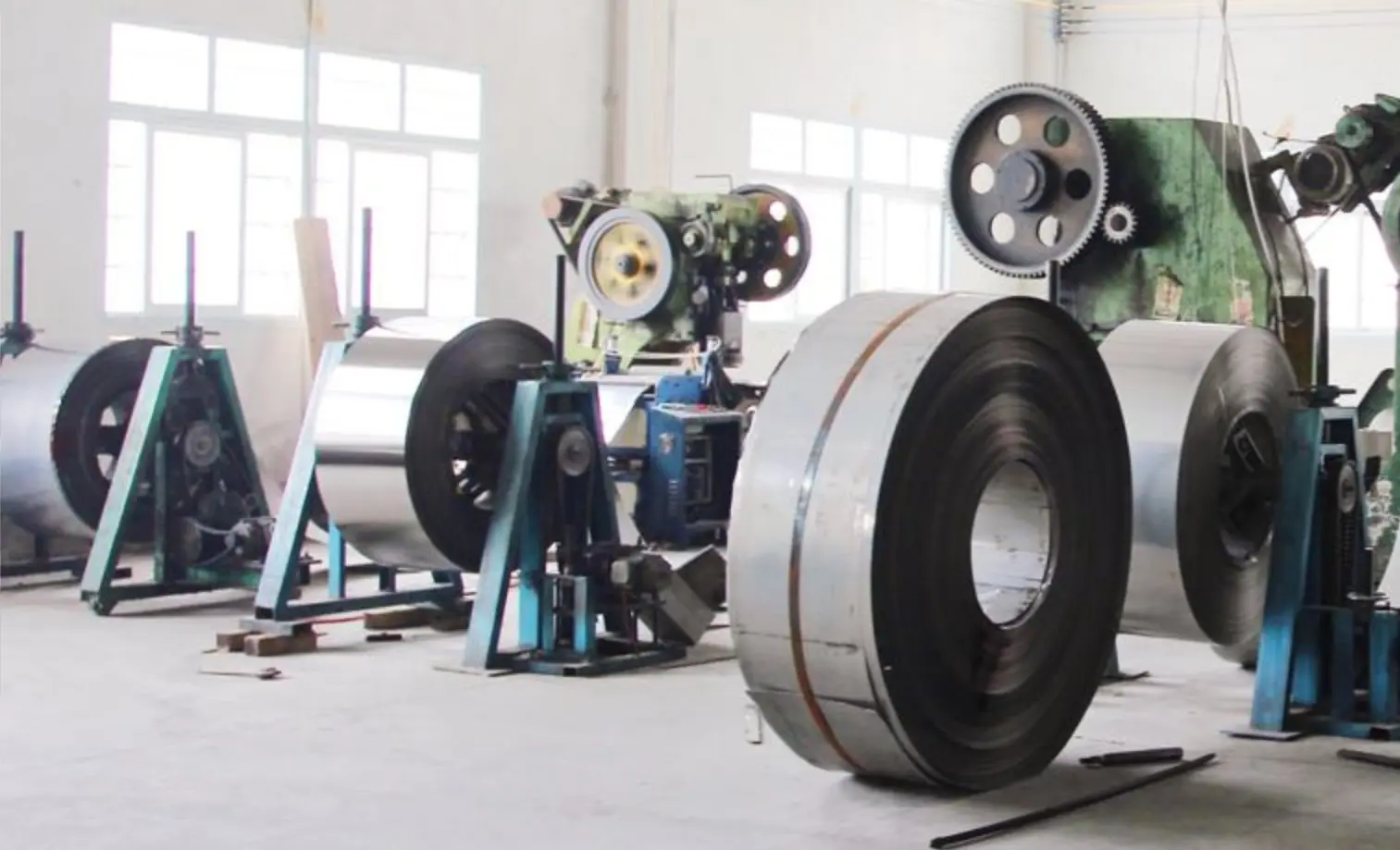
Paso 2: Corte de chapas de acero inoxidable
Una vez preparadas las materias primas, hay que cortarlas. La chapa de acero inoxidable del grado deseado se introduce en una máquina de corte que la trocea en tiras y láminas predefinidas. El trabajo debe hacerse con precisión, para que todas las piezas pasen a las siguientes fases dentro de unos parámetros definidos.
Normalmente se utilizan técnicas de corte por láser y plasma o corte hidráulico. Es el más adecuado para los diseños intrincados, ya que les proporciona un borde muy limpio y una gran precisión que sólo el corte por láser puede ofrecer. El corte por plasma, en cambio, es mucho más rentable cuando se trata de planchas más gruesas y funciona considerablemente más rápido. Sí, el corte hidráulico utiliza fluidos a presión para cortar el acero inoxidable y hace un trabajo eficiente en estos cortes más gruesos. El tipo de proceso de corte que se aplique dependerá de las especificaciones del producto en cada caso.
Durante el proceso de corte por láser, se dirige un rayo láser de alta potencia a lo largo de una línea definida con precisión sobre chapa de acero para fundirla y vaporizarla. Esta técnica permite obtener cortes precisos sin desperdiciar apenas material. Especialmente cuando se crean diseños ornamentales y patrones complicados en la superficie de la batería de cocina.
Aquí se utiliza el corte por plasma, en el que un chorro de gas ionizado a alta velocidad corta el acero inoxidable. Este procedimiento es más eficaz que los otros y también puede funcionar con chapas de acero inoxidable más gruesas. Suele utilizarse para piezas gigantes de utensilios de cocina que no tienen detalles finos.
Utilizando la fuerza del agua del grifo ensanchada para cortar acero, el corte hidráulico aplica fluidos a alta presión con el fin de forzar varias libras por pulgada cuadrada para atravesarlo rápidamente. Este proceso es más productivo de tal manera que se puede utilizar en placas pesadas y piezas de trabajo anchas para entregar componentes de precisión dimensional consistente.
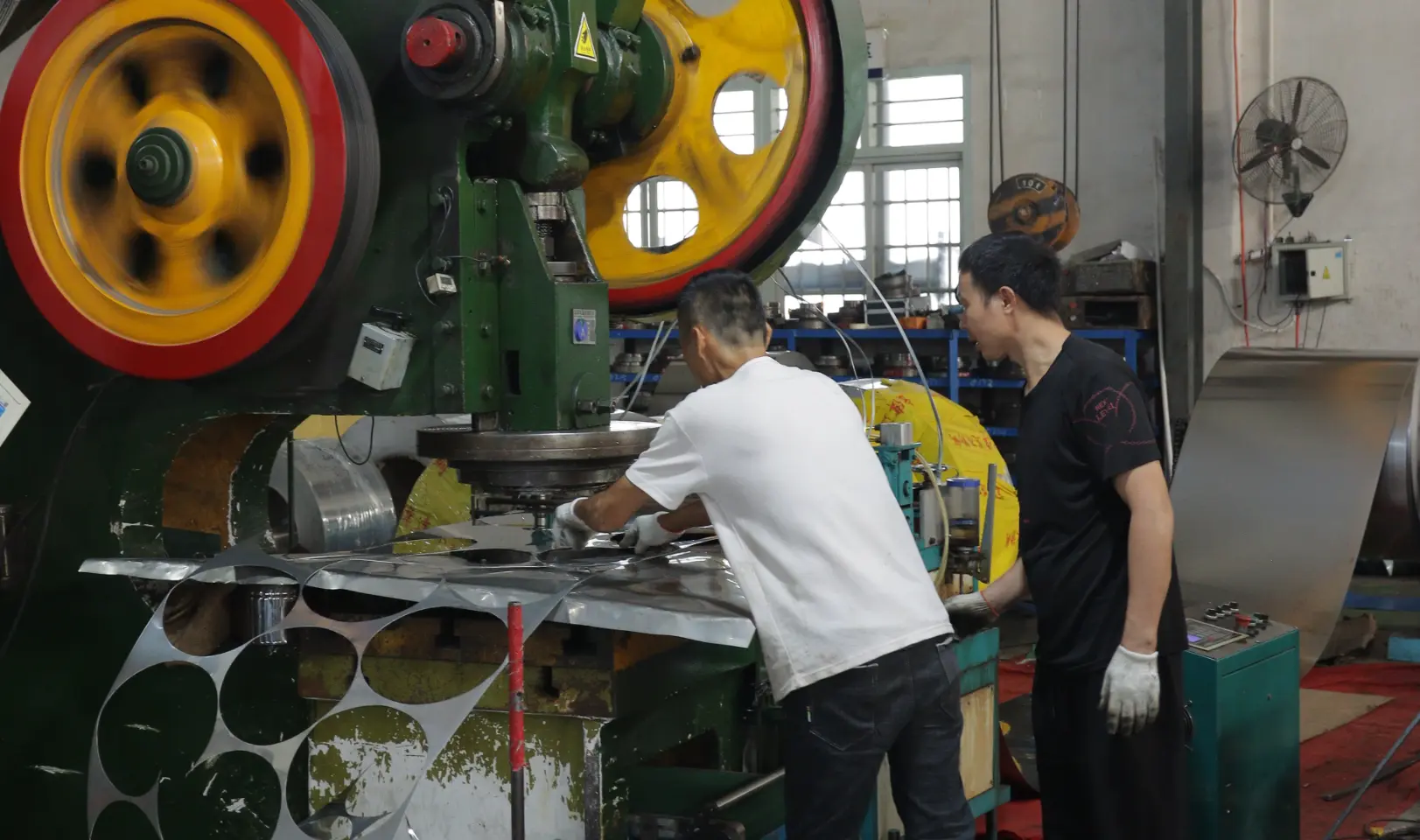
Paso 3: Rectificado del borde de los discos de acero inoxidable
Los extremos de las piezas de acero inoxidable suelen quedar ásperos y desiguales después de haber sido cortados. A continuación, se realiza un esmerilado en esos bordes para que las piezas queden lisas y listas para seguir trabajando. Este paso es esencial para que su batería de cocina sea segura y bonita.
Bandas o discos abrasivos: giran constantemente y se vuelven a tejer con nuevas capas abrasivas a medida que se desgastan para eliminar más material a la vez que se alisan los defectos. Es posible que necesite varias etapas de rectificado, por lo que debe empezar con abrasivos ásperos y luego progresar a abrasivos más finos. El resultado es una superficie plana sin bordes afilados ni rebabas.
El proceso de rectificado también es clave para obtener el grosor y la uniformidad deseados para cada pieza de la batería de cocina. Cada pieza se mide meticulosamente y se rectifica con las dimensiones exactas. Esto hace que el producto final sea consistente, al tiempo que acelera el montaje en una etapa posterior.
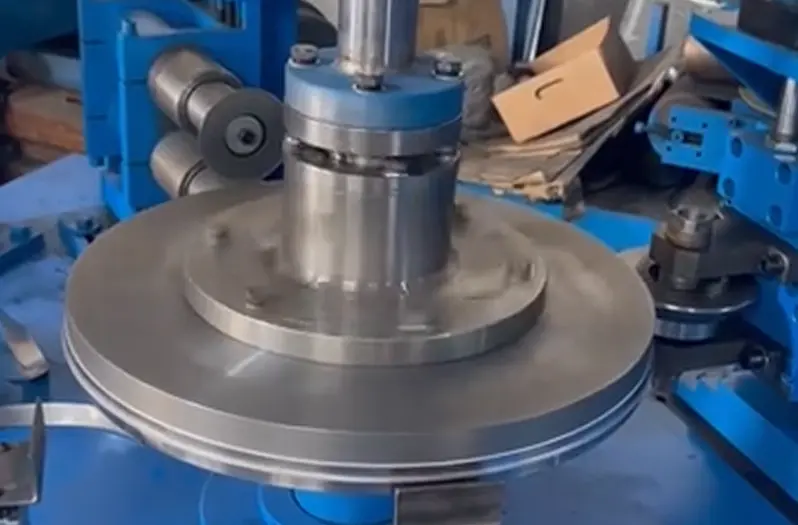
Paso 4: Dar forma a la batería de cocina (estirar)
Quizá la fase más interesante sea la de estirado, en la que las planchas planas de acero inoxidable se transforman en reconocibles ollas, sartenes y otros utensilios de cocina. El acero se estira y se le da la forma deseada con la ayuda de potentes prensas hidráulicas. Esto requiere una enorme fuerza y medidas exactas para garantizar que las planchas tengan una anchura uniforme de extremo a extremo.
Estirado (embutición profunda) Básicamente se coloca una chapa de acero inoxidable sobre una matriz, mientras el punzón la presiona para darle forma. Se repite tantas veces como sea necesario hasta obtener el contorno final, con recocidos intermedios para aliviar tensiones y darle forma.
La prensa de embutición profunda utiliza acero inoxidable sobre el que se ejerce una presión considerable, lo que hace que el material fluya en forma de matriz. Esto requiere un control preciso del punzón y la matriz para mantener la calidad y evitar efectos no deseados como arrugas o desgarros. Los lubricantes también son importantes para ayudar a reducir la fricción y garantizar que el estiramiento se produzca sin problemas.
El recocido medio consiste en calentar el utensilio a medio formar a una temperatura determinada y después mantenerlo hasta que se enfríe. Según la empresa, este proceso reduce las tensiones internas resultantes del estiramiento y aumenta la ductilidad del material. De este modo, el acero inoxidable adquiere una forma adicional sin romperse ni agrietarse.
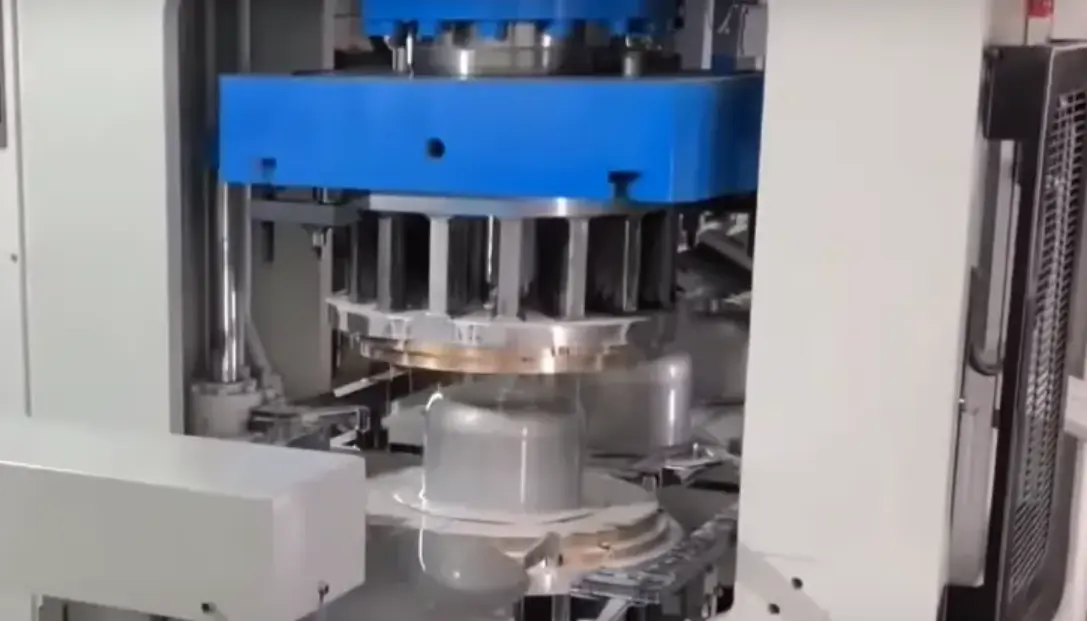
Paso 5: Hacer agujeros en las macetas de acero inoxidable
Durante el proceso de punzonado, se añaden características a sus artículos. El grabado puede ser para los agujeros de las asas, remaches o algún dibujo en la superficie. Cada utensilio de cocina se alinea y perfora con precisión para garantizar la precisión y la uniformidad.
Punzonadoras Los punzones y matrices se utilizan para hacer agujeros con el formato deseado. En el caso de los remaches, esto significa asegurarse de que todos los orificios estén perfectamente alineados para mantener una fijación adecuada. Además, se puede grabar un patrón decorativo o un logotipo en la superficie para aumentar su estética.
Las punzonadoras modernas disponen de varias matrices y punzones para realizar varias operaciones simultáneamente. Esto aumenta la eficacia y garantiza que todas las piezas se fabriquen con la misma calidad. La alineación y el posicionamiento de los punzones se regulan con precisión para que no admitan errores ni desajustes.
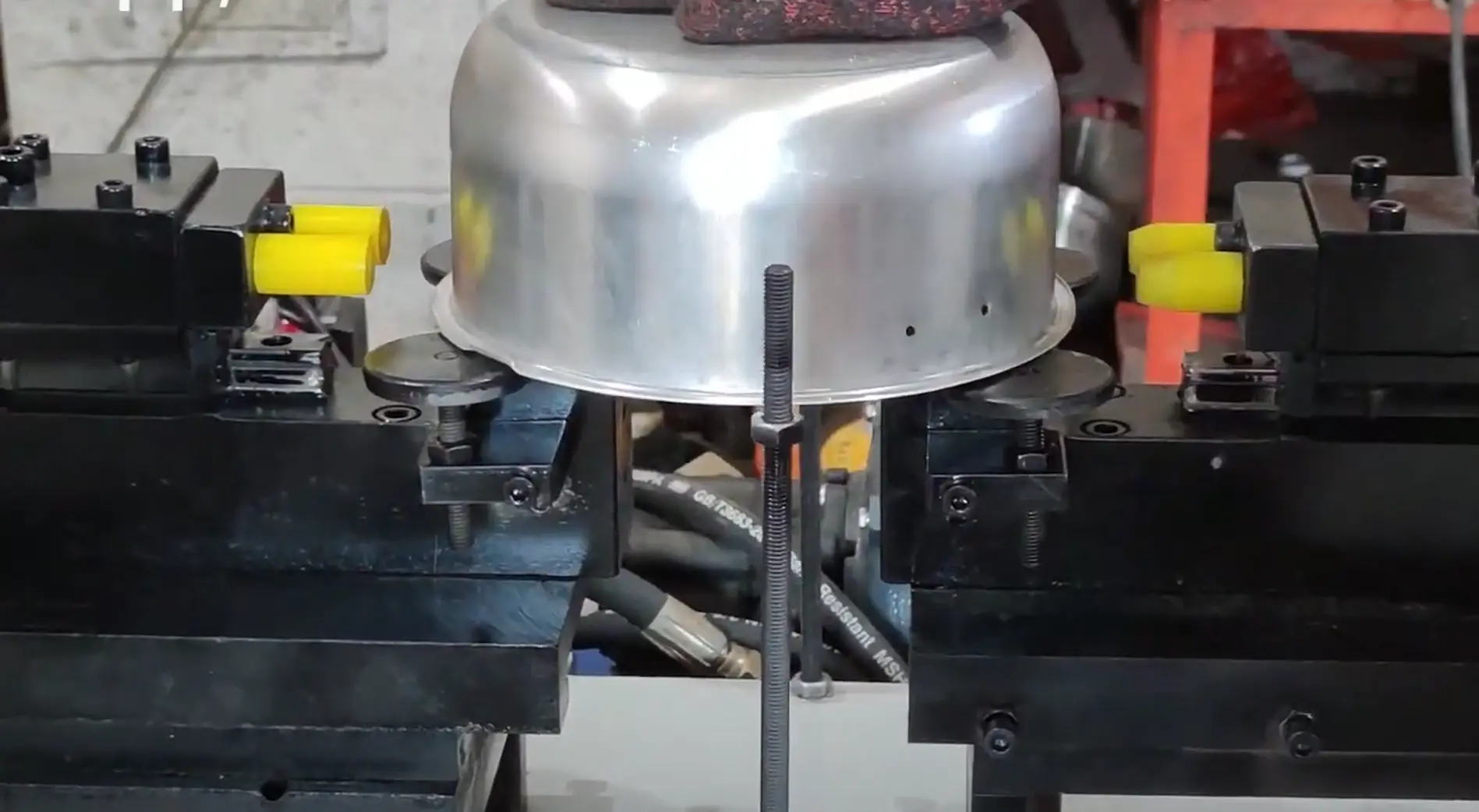
Paso 6: Recortar los bordes de los utensilios de cocina
Los bordes de las piezas de utensilios de cocina deben ser expulsados y recortados después del estirado y punzonado para darles su forma final. Las recortadoras eliminan el material adicional y alisan los bordes para que cada pieza se ajuste a las especificaciones finales. No hay forma de evitar este paso, ya que es lo que hace que todo funcione y tenga el aspecto deseado.
El proceso consiste en cortar utilizando cuchillas afiladas o cortadoras giratorias para reducir el material sobrante. Pero hace falta precisión para asegurarse de que todas las piezas de la batería de cocina sean iguales y no tengan defectos. Una diferencia en la forma o el tamaño de estos dedos puede afectar mucho al rendimiento y al aspecto final.
El rectificado también incluye el desbarbado y recortado de los bordes afilados creados en los pasos anteriores. De este modo, la batería de cocina queda protegida para su manipulación y uso. Los bordes recortados se inspeccionan por partes según la especificación pertinente.
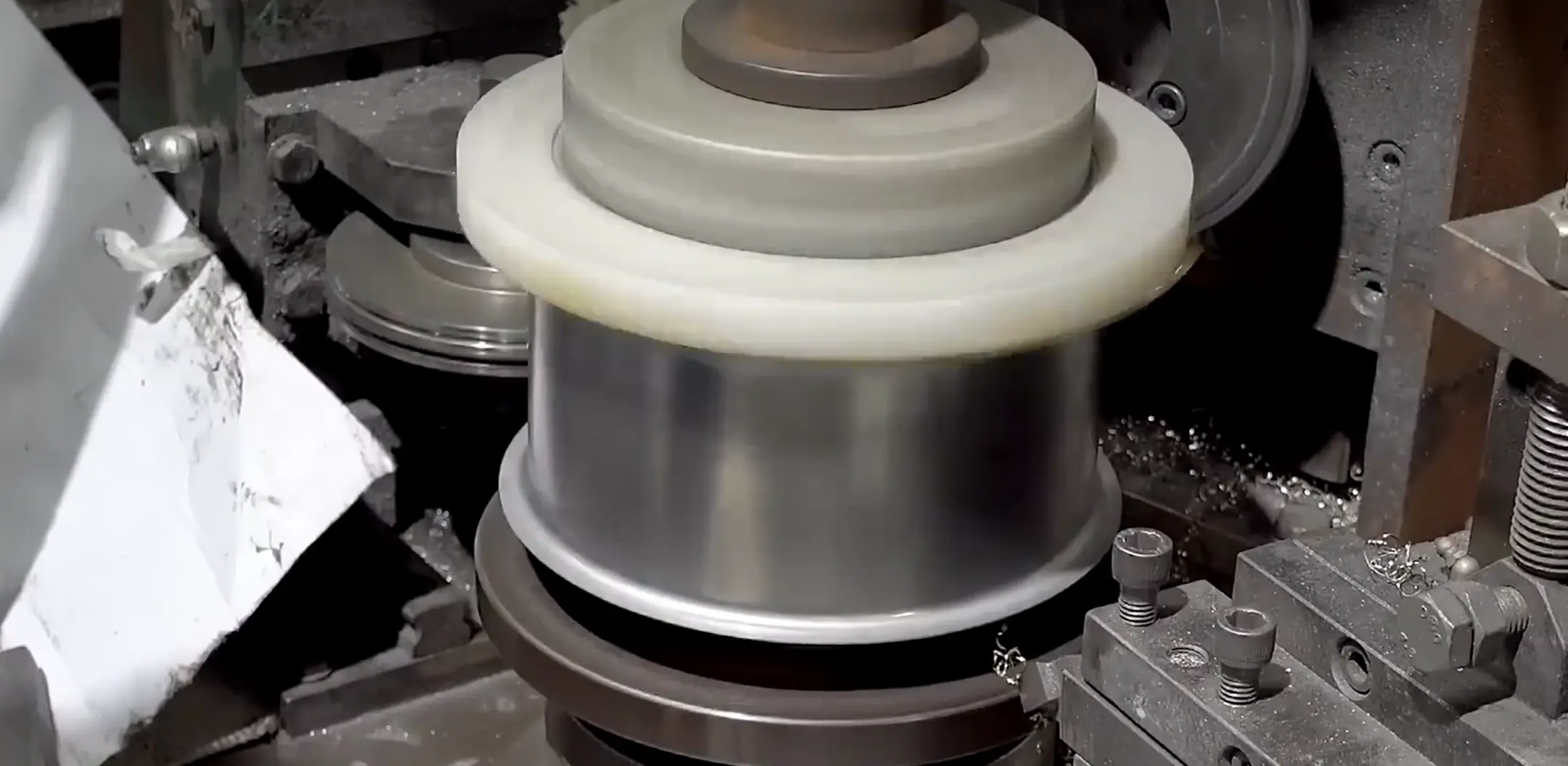
Stpe 7: Base de fundición - Máxima distribución del calor
Una característica de las baterías de cocina duraderas de acero inoxidable es la base encapsulada, también conocida como batería de cocina con "fondo sándwich" o base compuesta. En esta configuración, el material conductor (normalmente aluminio o cobre) se encapsula entre las capas de acero inoxidable. Con su base encapsulada, este modelo proporciona una distribución más eficiente del calor por toda la olla, de modo que nada quedará frío y crudo mientras que otras partes saldrán demasiado hechas.
La fundición Basey suele constar de tres fases: bases encapsuladas, revestimiento y unión por impacto.
Bases encapsuladas: El primer paso en la formación de una base encapsulada es la preparación de un material de núcleo conductor. El dúo de aluminio y cobre se selecciona por su conductividad térmica superior que facilita una transferencia de calor eficiente, lo suficientemente rápida como para nivelar la temperatura uniformemente. Estos metales reciben su nombre de los discos que se cortan para que coincidan con las dimensiones de la circunferencia de la base uno de estos discos para wok estufa eléctrica tops@Columna con unas pocas líneas Gema frases.
El siguiente paso es unir el núcleo conductor con acero inoxidable. Esto se consigue mediante un proceso conocido como revestimiento o unión por impacto.
El revestimiento: El acero inoxidable en un núcleo conductor y adyacente con rodillos de presión hidráulica. Luego pasan por un grupo de rodillos y la presión es tan intensa que lamina todas estas capas en una sola lámina Los discos cortados de esta lámina laminada proporcionan la base de estos utensilios.
Adhesión por impacto: Una segunda forma de fabricar una base encapsulada es mediante la unión por impacto. En este procedimiento, los discos de acero inoxidable y de núcleo conductor se alinean unos sobre otros y luego se presionan bajo golpes de alta energía, a menudo prensas hidráulicas. La velocidad de la colisión fusiona esas capas para formar una superficie dura e inflexible.
A continuación, los discos de base encapsulados dentro de las capas se recortan en redondo y sin rebabas. En esta fase hay que ser preciso; de lo contrario, no tendrían un aspecto uniforme ni encajarían correctamente con el cuerpo de la olla.
A continuación, los discos se fijan al cuerpo del utensilio. Lo habitual es utilizar la soldadura junto con métodos de fijación para conseguir una unión fiable y sin aislamiento. Para que funcione mejor, requiere una alineación perfecta de la base encapsulada con el cuerpo del utensilio.
La calidad de la base encapsulada está garantizada para asegurar la estabilidad y el rendimiento de la olla de acero inoxidable. Para ello es necesario realizar una serie de pruebas, entre ellas:
Prueba de durabilidad: La prueba de durabilidad evalúa la capacidad de la olla para resistir el alabeo y la deformación a altas temperaturas o con un uso frecuente.
Prueba de adherencia: Garantiza que las capas estén bien adheridas y no se desprendan durante el uso.
Prueba de conductividad térmica: Mide la eficiencia de la base en la conducción del calor.
Ventajas de las bases encapsuladas
- Distribución uniforme del calor: El núcleo conductor proporciona una distribución uniforme del calor por toda la superficie de cocción, eliminando los puntos calientes y favoreciendo la igualdad de temperatura de la placa de cocción.
- Alta eficiencia energéticaLa transferencia de calor más rápida y eficaz se traduce en tiempos de cocción más cortos y menos energía desperdiciada.
- Mayor robustez: El diseño encapsulado aumenta la estabilidad estructural de nuestras ollas y sartenes, lo que significa que son prácticamente resistentes a la deformación o rotura.
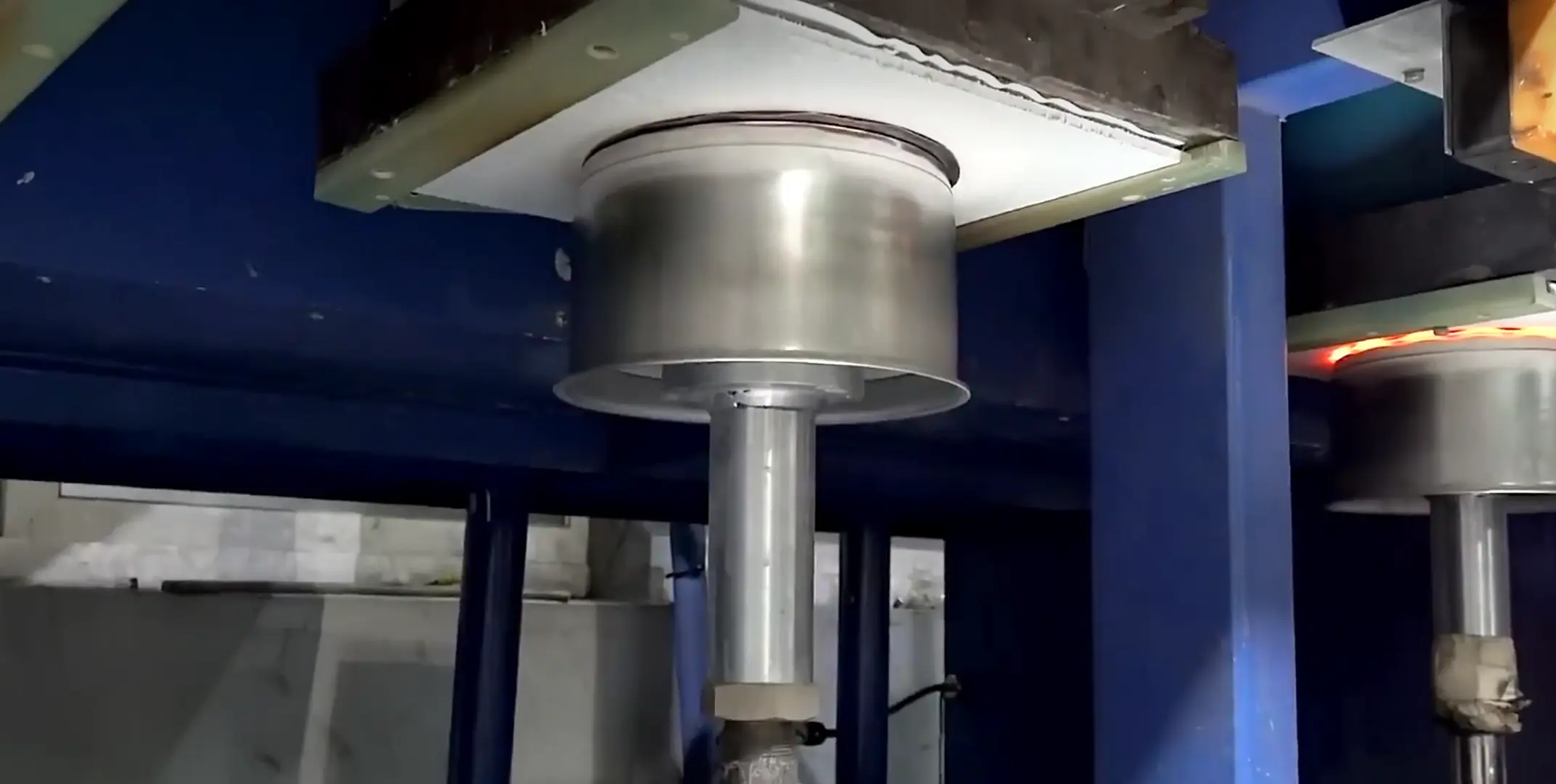
Paso 8: Pulido - Acabado de alto espejo
La fase de pulido es la parte en la que los utensilios de cocina adquieren su brillo característico. Este acabado es extremadamente brillante, requiere varios niveles de pulido y suele utilizarse en entornos sin polvo. Pero esta bandera no es sólo estética, sino que también actúa como una barrera de defensa adicional para evitar la corrosión.
El pulido es el proceso que produce una superficie lisa y reflectante mediante el uso de compuestos abrasivos y ruedas pulidoras. Se trata de un proceso en el que el primer abrasivo utilizado (el más grueso) elimina varias partes de la imagen, penetrando más profundamente de lo deseado. Los abrasivos subsiguientes son mínimamente menos agresivos: cada etapa hace progresivamente menos daño a esa zona tangencial completa que la operación anterior dejó más áspera. En la última etapa de acabado, se utilizan compuestos abrasivos finos para un pulido de alto brillo.
El pulido es un proceso que requiere tiempo y habilidad para obtener el resultado deseado. Tras el pulido, cada pieza de la batería de cocina se inspecciona y comprueba para garantizar que cumple nuestros elevados estándares. Se utilizan entornos libres de polvo para evitar su contaminación, lo que a su vez permite un acabado perfecto.
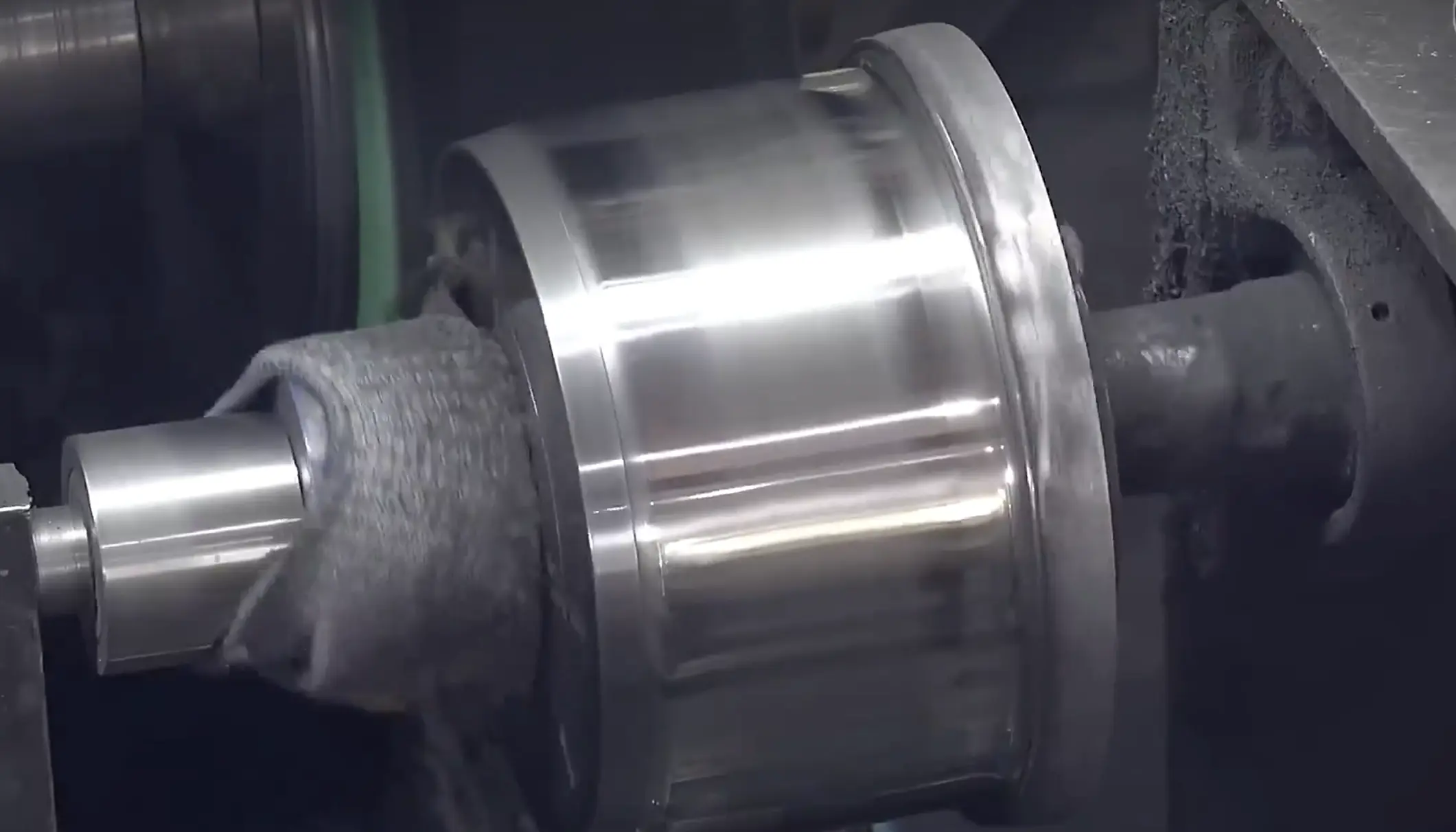
Paso 9: Añadir asa
Las asas facilitan el manejo de la batería de cocina, además de darle un aspecto diferente y elegante. En la fabricación de las baterías de cocina se utilizan asas incorporadas, en las que las asas deben soldarse o remacharse cuidadosamente a los cuerpos y se fijan en otros procesos denominados fijación. Las asas tienen que estar bien fijadas, ser frías al tacto y tener un diseño ergonómico para un uso cómodo en el proceso de fijación.
En el caso de los mangos de acero inoxidable, la soldadura es el procedimiento más habitual, ya que los hace prácticamente invulnerables al crear una fuerte unión que durará para siempre. Este proceso de unión se lleva a cabo calentando el mango y el cuerpo de la batería de cocina a alta temperatura y luego soldándolos. En cambio, el remachado consiste en pasar sujetadores metálicos a través de orificios preperforados y luego apretarlos entre sí para sujetar ambos extremos.
Por eso es esencial controlar estrictamente el aporte de calor y la velocidad de soldadura durante las operaciones de soldadura para evitar consecuencias indeseables, como alabeos o juntas debilitadas. Las juntas soldadas también se comprueban exhaustivamente para garantizar su resistencia.
Por otro lado, el remachado debe realizarse de forma muy metódica para que los remaches queden correctamente alineados y registrados antes de golpearlos.
Las asas resistentes al calor son cómodas de sujetar y permiten cocinar de forma más segura y fácil. Nuestras cocinas también tienen asas resistentes al calor, y estos productos también vienen con cómodos materiales de agarre.
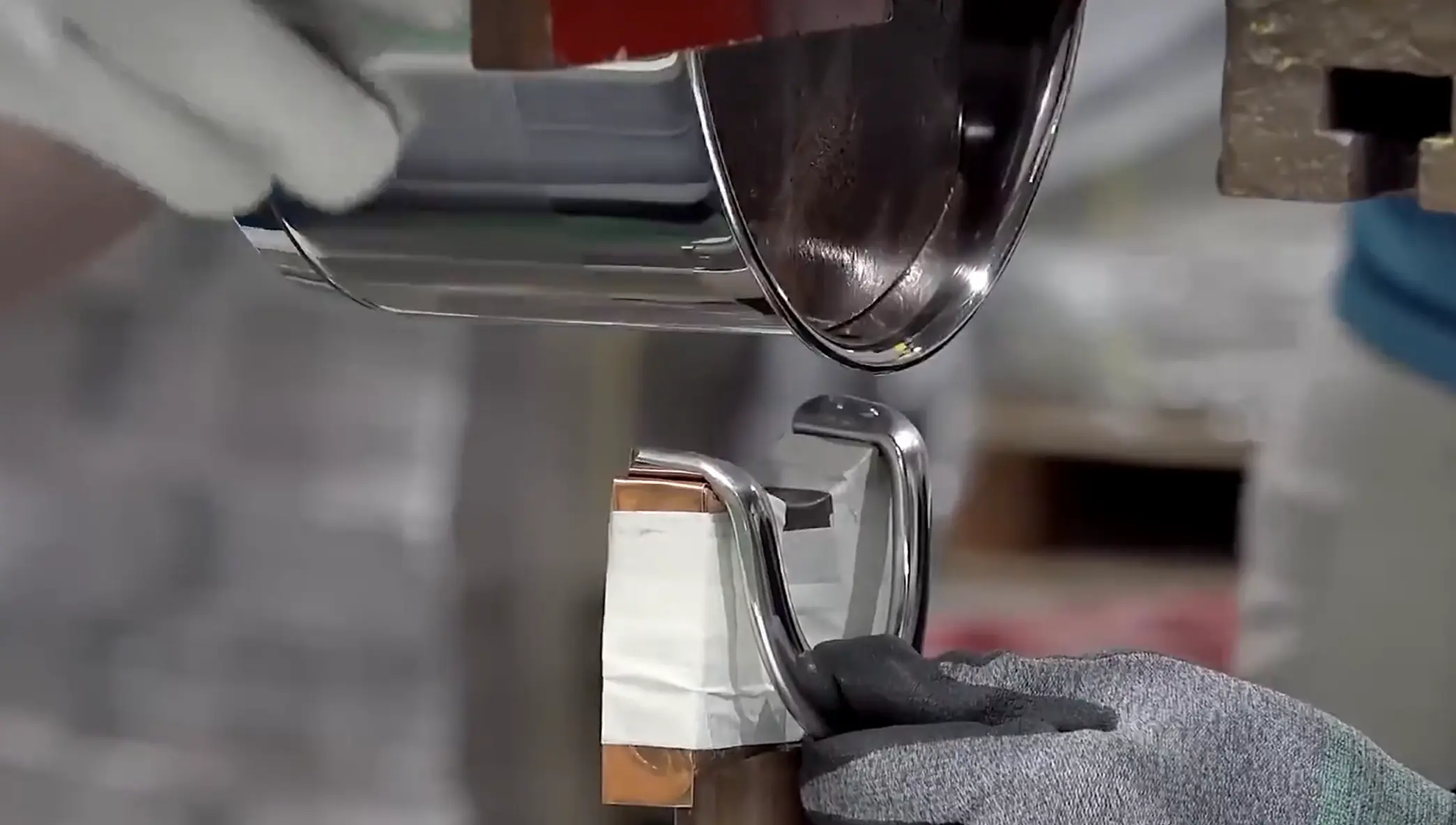
Paso 10. Inspección de calidad Inspección de calidad
El control de calidad constituye una parte integral del proceso de producción. Cada pieza de batería de cocina se prueba cuidadosamente para que rinda al máximo nivel. Pasan por un proceso de comprobación de imperfecciones, medición del grosor y prueba de durabilidad. Todo lo que supere los puntos anteriores será empaquetado y enviado.
La doble comprobación... una mediante inspección visual y la otra un proceso mecánico. La inspección visual detecta defectos superficiales como arañazos, abolladuras y decoloración. En cambio, las inspecciones mecánicas consisten en medir el grosor y el peso para garantizar que se cumple una norma específica. También se presta especial atención a los resultados de las pruebas de durabilidad realizadas sobre el tiempo, la resistencia a los golpes y la corrosión que verifican que los artículos de menaje pueden soportar el duro uso diario.
En particular, sólo se utilizan para este fin técnicas avanzadas de control de calidad como las pruebas ultrasónicas y la inspección por rayos X, ya que los defectos internos no pueden detectarse si no se muestran en la superficie. Ambas técnicas ofrecen una forma no destructiva de evaluar la integridad de los utensilios de cocina, lo que garantiza que solo se envíen a los clientes productos de la máxima calidad.
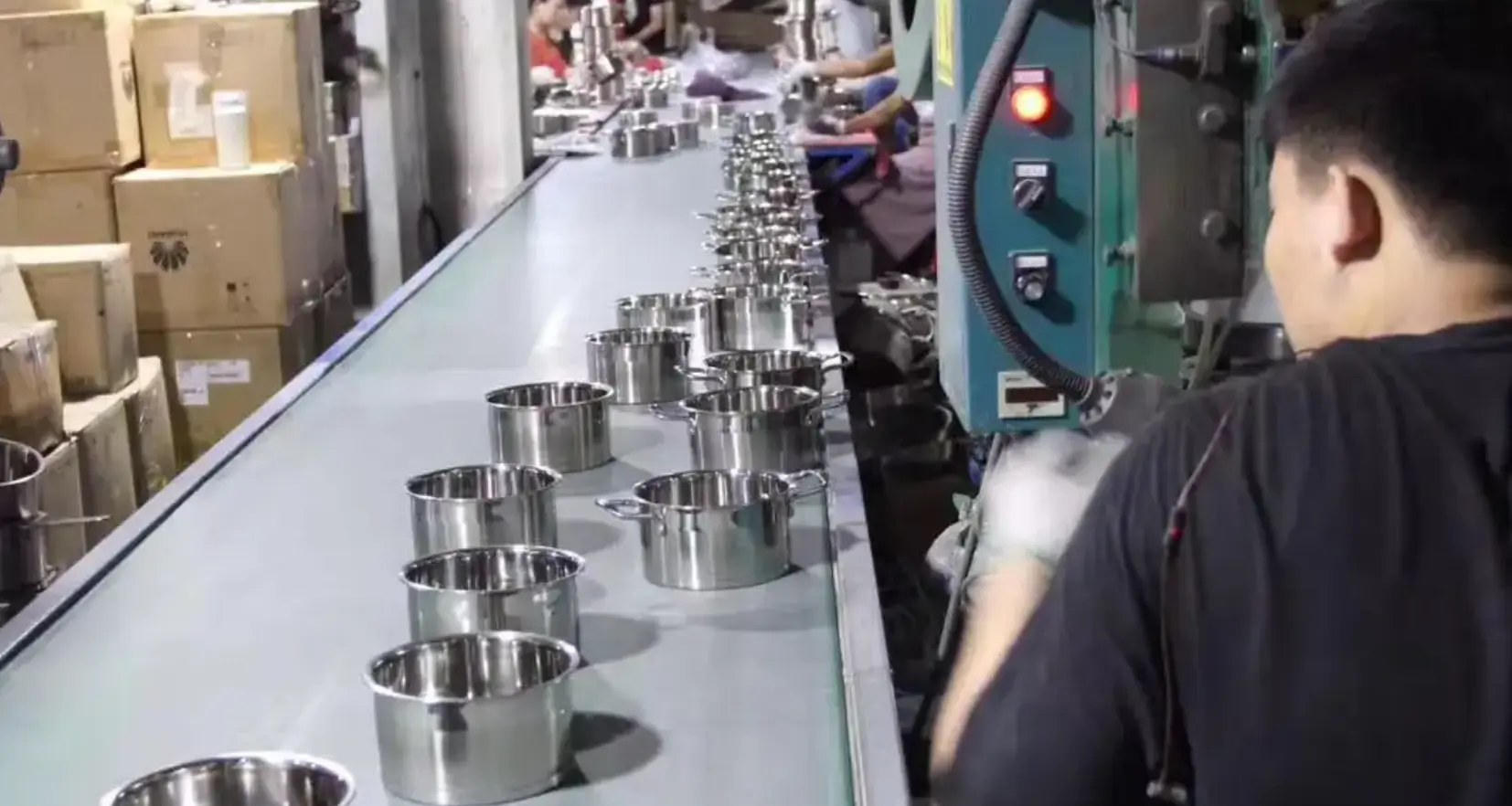
Paso 11: Empaquetar, prepararse para el mercado
Esta es la etapa final de la producción y consiste en el embalaje listo para ser enviado a los minoristas/consumidores. Para evitar dañar la pieza, cada una se empaqueta cuidadosamente en cualquier lugar. Embalaje: consiste en etiquetar y añadir elementos complementarios o documentación al producto.
A la hora de embalar, utilizamos material para que lo que su batería de cocina está siendo transportado en puede ser complementario de forma segura y si no habrá hacer ni un solo scratchOrDent de ella. Los utensilios de cocina se embalan en cajas resistentes y se sellan para evitar que entre humedad o polvo. Además, las etiquetas se cosen para dar información relacionada con el producto, es decir, características, especificaciones e instrucciones de cuidado, etc.
Incluso incluye la adición de accesorios, como tapas, asas o utensilios de limpieza. En segundo lugar, todos ellos han sido sometidos a pruebas y sólo los aprobamos si cumplen las mismas normas de calidad que nuestros utensilios de cocina. A partir de aquí, el producto final se empaqueta y está listo para ser enviado a los minoristas de todo el país y de todo el mundo.
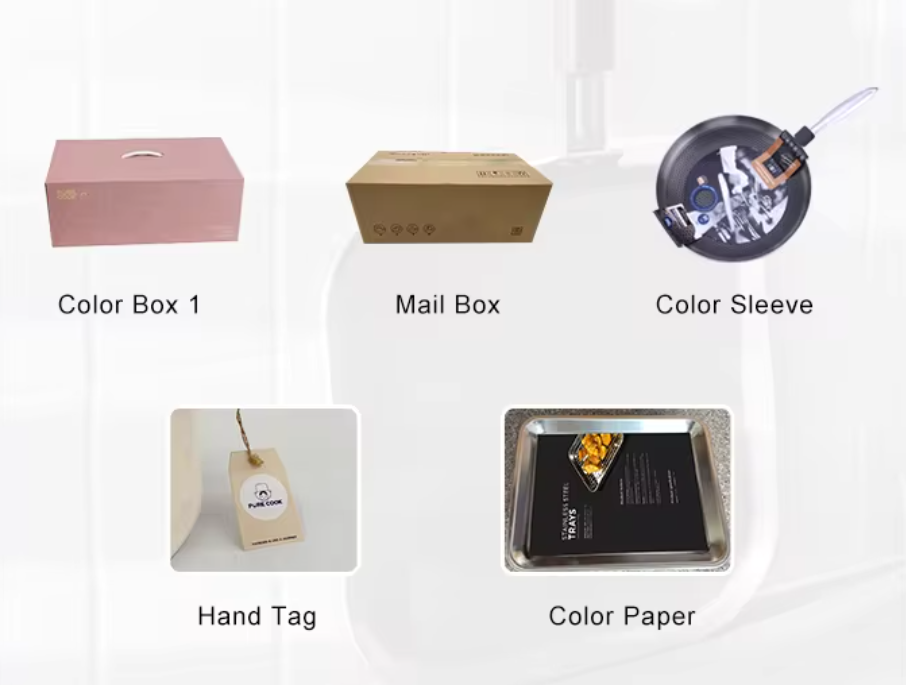
Protección del medio ambiente: Fabricación sostenible
En los últimos años, el sector de los utensilios de cocina también ha prestado cada vez más atención a las prácticas de fabricación sostenibles. En un esfuerzo por reducir su huella de carbono y tener una producción más sostenible, los fabricantes de utensilios de cocina están adoptando procesos de fabricación ecológicos. Esto se consigue mediante el uso de materiales reciclados, la reducción del consumo de energía y la minimización de los residuos.
Como el acero inoxidable puede fundirse y volver a utilizarse sin perder su calidad, la gente lo recicla mucho. Esto reduce la necesidad de recursos vírgenes, preservando las materias primas naturales. Además, los fabricantes llevan a cabo actividades de ahorro energético, tanto en lo que se refiere a la instalación de fuentes de energía renovables como a mejoras para optimizar el programa de producción como medio de reducir el consumo de energía.
Otra medida importante en la fabricación sostenible es la reducción de residuos: los fabricantes de utensilios de cocina de acero inoxidable trabajan para reducirlos utilizando los materiales de la forma más eficiente posible y reutilizando la chatarra. También aplican políticas de gestión de residuos para reducir y eliminar adecuadamente cualquier residuo producido.

Innovación en el diseño de utensilios de cocina
La industria de los utensilios de cocina siempre ha estado cambiando, y los fabricantes se desafían a sí mismos para que sus productos ofrezcan el mejor rendimiento y utilidad. Esto incluye el uso de elementos de diseño innovadores y materiales avanzados para mejorar el rendimiento y la durabilidad de la cocina.
Batería de cocina tricapa y multicapa: Estos son sólo algunos diseños que mejoran la dispersión del calor para reducir el tiempo de cocción. Estas ollas y sartenes de acero inoxidable tienen varias capas, que incluyen acero inoxidable junto con otros metales como aluminio o cobre para proporcionar características de conducción superiores y una cocción uniforme.
Los revestimientos antiadherentes también avanzan. Por otra parte, los revestimientos antiadherentes más recientes están formulados ahora para durar mucho más y ser menos propensos a rayarse o pelarse. Además, la mayoría son seguros para cocinar, ya que no contienen las nocivas sustancias químicas PFOA y PFOS.
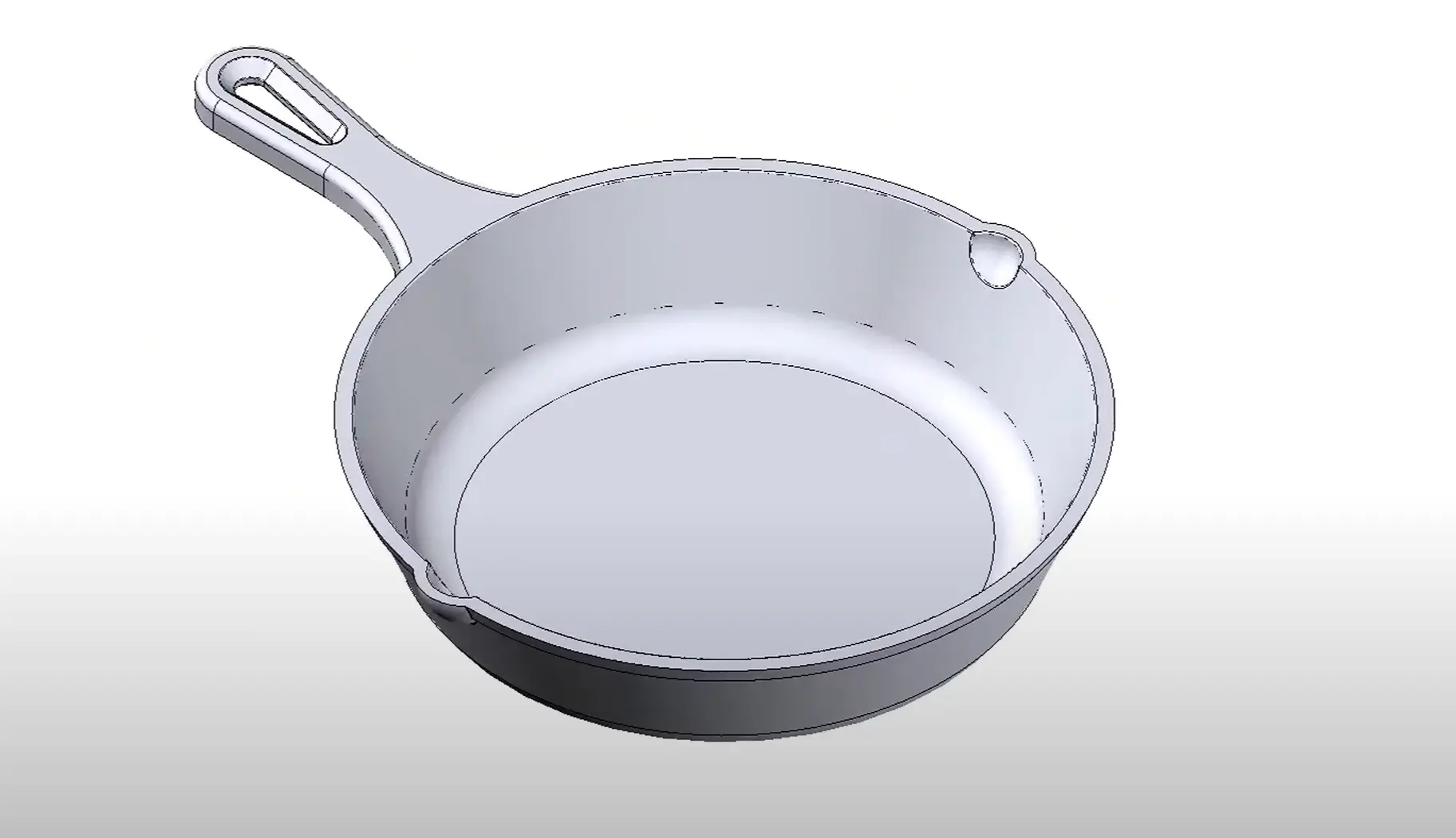
Conclusión
La batería de cocina de acero inoxidable es un conjunto de productos exigentes que requieren tanto tecnología avanzada como artesanía fina. La calidad y el rendimiento son los objetivos desde la selección de la materia prima hasta el pulido final. Si sigue esta guía, después de conocer estos procesos sabrá lo valiosa y hábil que ha sido la batería de cocina que utiliza a diario. Cuando busque la batería de cocina de acero inoxidable más excelente para cualquier cocina profesional o doméstica, debe ser un tipo de inversión que siga sirviéndole a lo largo del tiempo, si no para siempre.
Envíe sus ideas de menaje de cocina personalizado
¿Le inspira la meticulosa producción de utensilios de cocina de acero inoxidable? ¿Tiene un estilo o plan específico para su cocina? PURECOOK ofrece baterías de cocina de acero inoxidable personalizadas, y todas nuestras baterías de cocina están diseñadas y fabricadas con una calidad duradera.
Ofrecemos opciones de personalización ilimitadas. Puede diseñar una batería de cocina de cualquier dimensión, como material, tamaño, revestimiento, color, etc. Nuestro equipo de expertos y nuestra línea de producción profesional le ofrecen el mejor apoyo durante todo el proceso.
Desde hoteles que carecen de utensilios de cocina a granel de alta calidad, hasta entusiastas de la cocina que buscan herramientas ingeniosas que no están disponibles actualmente en el mercado, o incluso cualquier minorista que desee obtener y ofrecer nuevos productos únicos. Sea cual sea la ayuda que necesite, nuestro equipo de expertos le ayudará en todos los eslabones, desde el diseño hasta la producción.
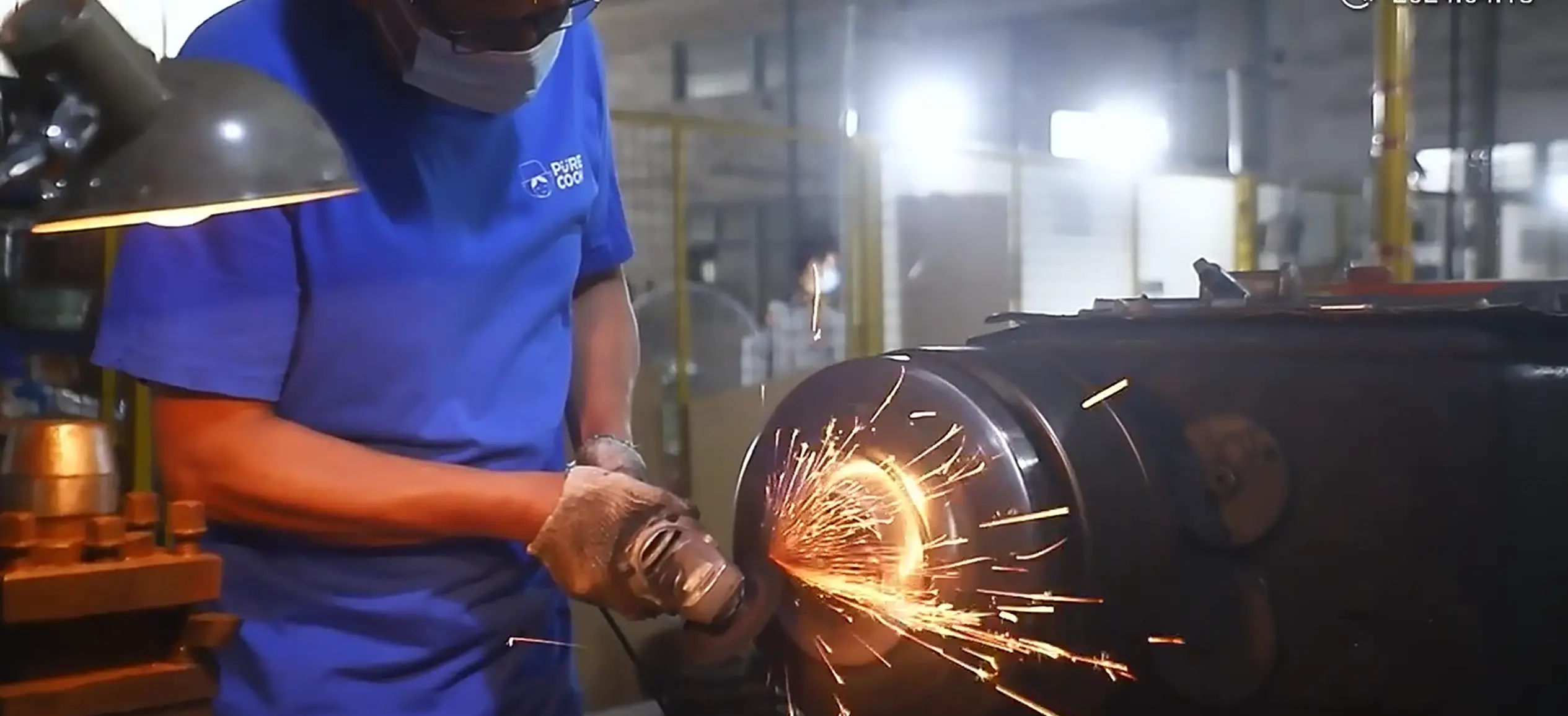
Acerca de Purecook
Purecook es uno de los fabricantes de utensilios de cocina más conocidos de China. En los últimos 30 años, hemos proporcionado OEM y ODM. soluciones de menaje a medida para grandes y pequeñas empresas de todo el mundo. Siempre mantenemos una colaboración eficaz y la mejor relación de socios con los clientes. Incluso si los clientes no tienen claro qué tipo de menaje de cocina necesita su empresa, también confiamos en los conocimientos profesionales y la capacidad de ayudar a los clientes a comprender mejor la situación del mercado, razón por la cual nos hemos ganado la confianza de muchos clientes.
De hecho, tenemos diversas capacidades. Contamos con un equipo profesional de I+D compuesto por diseñadores, expertos en materiales y técnicos, por lo que podemos hacer personalizaciones ligeras y personalizaciones profundas. Hemos fabricado más de 550 estilos de serie de utensilios de cocina profesionales para satisfacer las necesidades de los compradores de la mayoría de las regiones.
Contamos con la línea de producción profesional líder del sector y hemos establecido un estricto sistema de inspección de calidad para llevar a cabo la inspección de calidad 100% de los productos. Nuestra venta al por mayor de utensilios de cocina son muy apreciados por su alta calidad y larga vida útil.
En términos de servicio, nuestro equipo de cámaras ofrece a los vendedores de Amazon servicios gratuitos de toma de imágenes de alta calidad y servicios de optimización de vídeo de productos.
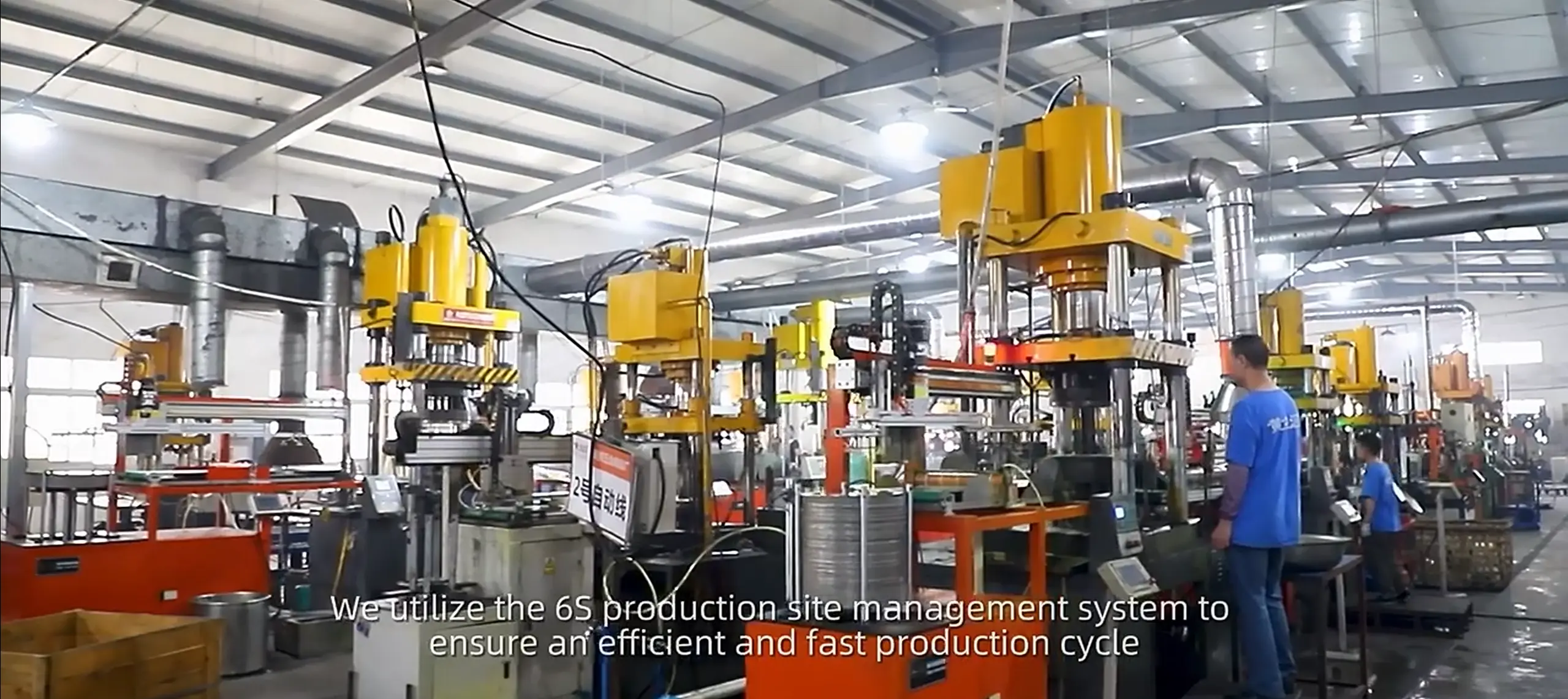
Póngase en contacto con nosotros
Deje de comprometerse con los utensilios de cocina insatisfactorios del mercado. Póngase en contacto con nosotros para discutir sus necesidades y para obtener un presupuesto personalizado de utensilios de cocina de acero inoxidable. Visite nuestro sitio web en http://www. purecook. com para iniciar la conversación. Únase a nosotros y empecemos a trabajar juntos en utensilios de cocina que estén a la altura de su potencial.
Póngase en contacto con nosotros
No dude en llamarnosjoy@purecook.com
No dude en ponerse en contacto con nosotrosNo.68 Xianhua Road,HuaqiaoVillage,Caitang Town,Chao'an District,Cha ozhou City,Guangdong Province
